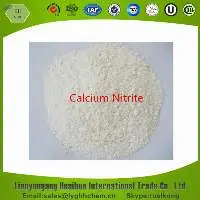
Supplier: Nickel sludge, zinc ash, copper ore, lead ore, chrome ore, manganese ore, bauxite ore, iron ore, iron ore pellets, tin ore, ir64 rice, ir 64 5% broken rice, zinc ash, raw red chilli, chrome ore, iron skull, 1121 sella white basmati rice, 3 ply surgical masks
Buyer: Zinc ash, copper concentrate, lead ore, tin ore, nickel sludge
English name: Calcium Nitrite Molecular formula: Ca(NO2)2 Molecular weight: 132 CAS NO. 13780-06-8 HS CODE: 28341000 UN NO.: 2627 5.1 type oxidizing agent Properties: White powder without crystal water. It is tasteless and toxic. Easily in water and presents light yellow solution. Specifications: Item Superior grade First grade Second grade Calcium Nitrite[Ca(NO2)2 as dry basis]% 94 92 90 Calcium Nitrate[Ca(NO3)2 as dry basis]%
1,Name: Sodium nitrite Molecular formula: NaNO2 Formula weght:69.00 2Property: (1) ordinary sodium nitrite: white little crystals or light yellow  (2) dry powder sodium nitrate: white crystal,non-caking, showing loose status. Density:2.168. No odor, slightly salty. It is liable to deliquesce, dissolved in water,soluble in liquid ammonia,slightly soluble in ethanol and glycerin,Melting Point:271. Decomposition temperature is 320. It has oxidability and also has reducibility. It will slowly be oxidized into sodium nitrate in atmosphere, it can form nitrogen compound with nitrilo at low temperatures. 3Usage:It has been widely used in making nitro-compound and azo dye, mordant of textile dyeing, bleaching agent, metal heat finishing agent, cement early strength agent, and deicing agent etc. Note: The product should be stored in a cool, dry place to prevent it from moisture, heat and sunlight. This product can not be mixed with strong reductant, inflammable and explosive materials, food, feed and additives. â?¢ This product is toxic and should be properly kept and can not be eaten. 4 Specification: (Technical Standards:GB2367-2006) Item Unit Molten salt G High G First G Qualified G Dry powder G Assay % 99.3 99.0 98.5 98.0 98.5 Sodium nitrate % 0.6 0.80 1.00 1.90 0.80 Chlorides % 0.03 0.10 0.17 -- 0.1 Water insolubles % 0.02 0.05 0.06 0.10 0.06 Moisture % 1.0 1.4 2.0 2.5 0.2 Loose degree -- -- -- -- 95 5,Package: net 50kg net each in plasic woven inner plasic bag, or according to customers requirement.
L-Cystine powder, CAS No.56-89-3, formed by the oxidation of two cysteine molecules, a non-essential amino acid. It is used as a component for parenteral and enteral nutrition and the main active ingredient for medications used to treat dermatitis. Cystine along with the amino acid methionine are the amino-acids necessary for wound healing and forming of epithelial tissue. Cystine is known to stimulate the hematopoietic system and promote the formation of white and red blood cells. As an experienced L-Cystine manufacturer and supplier, we has been supplying and exporting L-Cystine for almost 10 years, please be assured to buy from us. Any inquiries about price and the market trend please feel free to contact us, we will reply you within 1 working day. Product Description Categories Amino Acids Qty in 20 FCL 18000kg Min Order 500kg Origin China Packaging Factory Packaging or Neutral Certificate ISO, Kosher, Halal, BRC CAS No. 56-89-3 HS Code 293090 Specification Feed/Food Grade L-Cystine Specification Item STANDARD Specific rotatory power[±] D20 -215 -225 Clarity 98.0% Ammonium salt[NH4] 0.02% Chloride[CL] 0.02% Residue on ignition 0.10% Sulfate[SO4] 0.02% Iron salt[Fe] 10 ppm Heavy metal[Pb] 10 ppm Arsenic salt 1 ppm Other amino acid Color layer can not be checked out. Loss on drying 0.20% Content 98.5 -101.0%
Supplier: 1. ashwagandha extract 1.5% 2. zingiber officinale 2.5% 3. glycine powder 4. black seed oil 5. flax seed oil 6. castor oil (clear) 7. black pepper extract 95% 8. curcumin 95% 9. aloe vera 200x 10.. potassium sorbate 11. propylene glycol
Supplier: 1. carbon black
2. rubber crumb
3. precipitated silica
4. silica quartz ore purity: 98% available, silica quartz powder/purity: 99.9% available, silica lumps purity: 99% available
5. calcium chloride powder 74% cacl2 92% cacl2 94%
6. magnesium chloride flake
7. sodium meta bisulphite (food grade 94 96%)
8. red onion as per your required size.
9. sodium acetate anhydrous 99% sodium acetate trihydrate crystal 99%
10.pet preform & fiber, bottle, flakes,
11.bopp tapes
12. capsicum or bell pepper, ready to eat foods, ready green paste like ginger, garlic paste
Services: We also do logistic work for cif and we have 3rd party facilities like sgs on client chargeable base.
1 117-81-7 Bis(2-ethylhexyl) phthalate 2 117-84-0 Di-n-octyl phthalate 3 85-69-8 Butyl 2-ethylhylhexyl phthalate 4 84-61-7 Dicyclohexyl phthalate 5 84-74-2 Dibutyl phthalate 6 84-69-5 Diisobutyl phthalate 7 131-11-3 Dimethyl phthalate 8 84-66-2 Diethyl phthalate 9 20548-62-3 Bis(7-methyloctyl) phthalate 10 68515-49-1 Diisodecyl phthalate 11 84-75-3 Di-n-hexyl phthalate 12 6422-86-2 Dioctyl terephthalate 13 137-89-3 Bis(2-ethylhexyl) isophthalate 14 123-79-5 Dioctyl adipate 15 122-62-3 Bis(2-ethylhexyl)sebacate 16 109-43-3 Bis(n-butyl)sebacate 17 512-56-1 Ttrimethyl phosphate 18 126-73-8 Tributyl phosphate 19 8013-07-8 Epoxidized soya bean oil 20 77-93-0 Triethyl citrate
1 108-78-1 Melamine 2 37640-57-6 Melamine cyanurate 3 63428-83-1 Polyamide 4 106-50-3 1,4-phenylenediamine 5 9002-89-5 Poly(vinyl alcohol) 6 105-60-2 �µ-caprolactam 7 10578-34-4 Stearyl benzoate 8 108-31-6 Maleic anhydride 9 108-05-4 Vinyl acetate 10 26264-06-2 Calcium dodecylbenzene sulfonate 11 111-69-3 Adiponitrile 12 924-42-5 N-Methylolacrylamide 13 100-20-9 Terephthaloyl Chloride 14 99-63-8 Isophthaloyl Chloride 15 1338-02-9 Copper naphthenate 16 6153-56-6 Oxalic acid dihydrate 17 79-10-7 Acrylic acid 18 75-01-4 Chloroethene 19 25190-06-1 Poly(butylene oxide) macromolecule 20 77-99-6 Trimethylol propane
S.N CAS No. Item 1 100-21-0 Terephthalic acid 2 67763-03-5 Silsesquioxanes 3 9003-01-4 Acrylic acid 4 1333-86-4 Carbon black 5 80-62-6 Methyl methacrylate 6 61788-97-4 Haloperidol 7 75-38-7 1,1-difluoroethylene 8 100-42-5 Styrene 9 9002-84-0 Poly(tetrafluoroethylene) 10 124-04-9 Adipic acid 11 107-21-1 Ethylene glycol 12 126-30-7 Neopentyl glycol 13 85-44-9 Phthalic anhydride 14 106-89-8 Epichlorohydrin 15 9003-08-1 Amino resin 16 9006-03-5 Chlorinated rubber 17 13463-67-7 Titanium dioxide 18 12227-89-3 Iron Oxide Black 19 922-67-8 Methylpropiolate 20 538-24-9 Trilaurin 21 9011-05-6 Urea formaldehyde 22 79-41-4 Methacrylic acid 23 1314-13-2 Zinc oxide 24 80-05-7 Bisphenol A 25 121-91-5 Isophthalic acid





